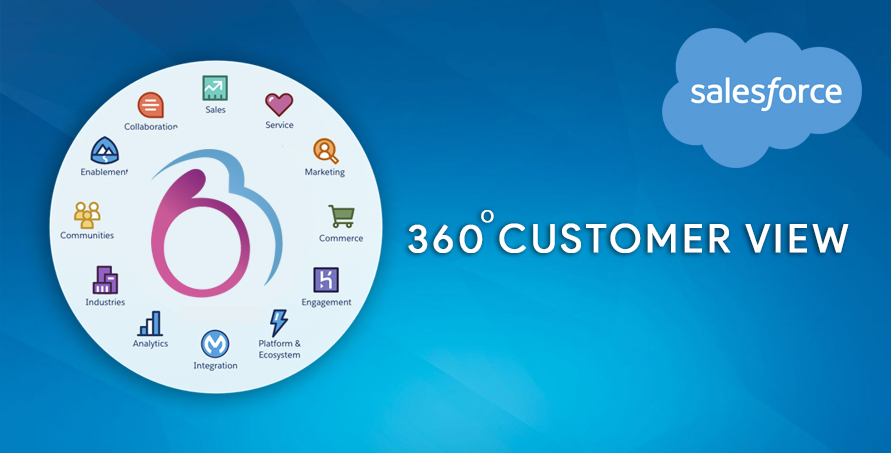Storehouse Buster: Salesforce Attacks the Data Sprawl Issue
 360-Degree View of the Data
360-Degree View of the Data
Be that as it may, you can and ought to build up a 360-degree perspective of your client information. That is, you ought to have the capacity to get your arms around every one of the information you’ve accumulated about every client, compose it, and view it in context.
That sounds basic, however in the course of the most recent decade we’ve made sense of approach to undermine this exertion. The appearance of the cloud made it simple for sales, marketing and support to execute frameworks that inadvertently reconstructed the storehouses that CRM guessed thump down.
This has brought about what could be classified “information sprawl“: The more client information we catch, the more places it dwells inside the business.
The cloud – amusingly, a wonder that Salesforce crashed into mass acknowledgment – frequently removed IT from the condition, so when information sprawl was viewed as an issue, the assignment of re-binding together the information was truly difficult work rather than a basic change.
Add to that the craving of clients to speak with the organizations they purchase from through whatever channel they believe is best for what they’re attempting to convey – abruptly, the information is spread further, into more storehouses.
The information tale about every client winds up divided, segregated inside divisions, and fantastically hard to gather.
I’ve expounded on this very issue myself (strikingly, here and, all the more as of late, here). That is the reason I was so satisfied to catch wind of Salesforce’s standard declaration for Dreamforce 2018, Salesforce Customer 360.
Regularly, enormous occasion declarations are arrangements looking for an issue (or arrangements looking for future programming improvement). For this situation, Salesforce is training in on a longstanding issue and conveying an answer laser-concentrated on settling it.
Salesforce’s Customer 360
The possibility of Customer 360 is to gather all client information in one place – and information from the different Salesforce clouds as well as, through the MuleSoft Anypoint Platform, from different applications. The Anypoint Platform interfaces the applications’ APIs straightforwardly to Customer 360.
This is the mystery sauce that makes the declaration extremely delectable, on the grounds that it handles a genuine issue. No organizations utilize an only Salesforce stack for sales, marketing and service; Customer 360 accommodatingly maneuvers this information into the client record.
The Salesforce part of the condition appears to be well thoroughly considered. After the APIs have been associated, a tick based UI enables the administration of the information to be mapped and accommodated. That makes a solitary portrayal of the information, maintaining a strategic distance from the danger of physically gathering similar information and perhaps putting diverse needs on various client information each time the record is analyzed. Naturally, the majority of this can be seen from inside Salesforce.
This doesn’t imply that Salesforce is making a huge new information lake or distribution center, which can challenge application execution and the client’s money related assets. Client 360 leaves the information in its arrangement of beginning while likewise utilizing a solitary ID for every client; when the framework pulls information for a client, it’s the latest information in indistinguishable grouping from before.
Salesforce is putting forth prebuilt bundles for Customer 360 for administration, marketing and business. That struck me at first as somewhat counter to the idea of a bound together perspective of the information until the point when I ventured back and put my client cap on: Yes, the information is the same, and the innovation being utilized to convey it is the same, however clients of that information need it displayed in a shape that mirrors their job and how they intend to utilize it.
Takes care of a Real-World Problem
This declaration ought to satisfy IT administrators, who will have a decent beginning spot to unravel their information storehouses, but at the same time it’s probably going to please individuals who never observe the Salesforce interface by any means – clients.
The danger of having a cracked perspective of client information is that it makes a broke ordeal for the client – or, rather, keeps organizations from making associated encounters for the client.
Discussions did in talk might be isolated from subsequent meet-ups that occurred by means of email. Administration accounts and deals examples might be contained in various frameworks. Installment subtle elements and examples of purchasing might be followed in various frameworks.
The impact for clients is that the business appears to be not able comprehend their identity, regardless of what number of cooperations they have with the business, and the client encounter endures as a result of it.
Following quite a while of shows including rambles, man-made brainpower, showy investigative interfaces and other fascinating if not in every case promptly impactful thoughts, Customer 360 purposes a prickly certifiable issue that can convey a positive effect to business rapidly.




